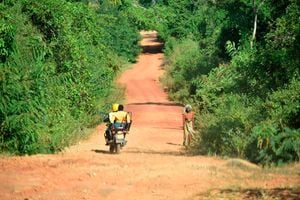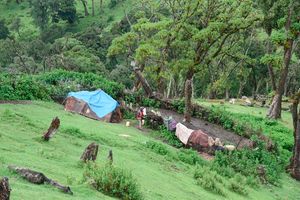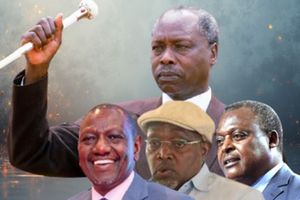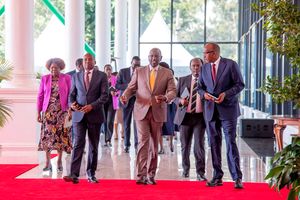
Scattered bamboo plants spotted at Kaptagat Forest in Elgeyo-Marakwet County on October 10, 2024.
The most recent Auditor General's report has lifted the lid on the possible loss of Sh147.7 million that investigators say mysteriously vanished into thin air.
The report reveals that the accounting officials in the Ministry of Environment and the Kenya Water Towers Agency (KWTA) could not explain how the money was spent in relation to a bamboo project in Kaptagat Forest, which the auditor general flagged as a ghost project.
"The audit revealed the site was neglected and had minimal activity towards establishing a bamboo demonstration centre. This is despite the Agency having spent Sh147.7 million between 2017/2018 to 2021/2022 towards the establishment of the bamboo enterprise," Ms Nancy Gathungu, the Auditor General highlights in her report.
It all began towards the end of July 2019. The government had injected Sh147.7 million taxpayer money into what was supposed to be a 50-acre bamboo demonstration site in Kaptagat Forest, sponsored by KWTA, and jointly implemented by Kenya Forest Service, County Government of Elgeyo-Marakwet and Kenya Forestry Research Institute.
The Sh147 million placed under the care of KWTA was meant to be used to build capacity and grow a bamboo forest. It was also supposed to foster community engagement and public participation in the project to help residents understand the bamboo ecosystem.
Following the Auditor General's report, Nation.Africa went to Kaptagat Forest to find the bamboo plantation. There was none. Instead, we found no evidence of ever there being a bamboo plantation at the site, yet money had already been spent.
Back in 2012, KWTA, a brainchild of President Mwai Kibaki, was set up to coordinate and oversee the protection, rehabilitation, conservation and sustainable management of water towers.
For the bamboo project in Kaptagat, KWTA reported that it started off by planting five acres of seedlings and said an additional 45 acres would be planted by the end of the same year. This means that Kaptagat Forest should be bustling with lush bamboo trees by now.
But the Auditor General says in her report that her investigations "did not find any six-year-old bamboo trees" at the site.
While responding to the findings in an official letter, Prof Julius Gordon Tanui, the KWTA Chief Executive, said the organisation in the financial year 2017–2018 received Sh13,466,955 and Sh103,877,123 in 2018–2019 financial year.
He said in 2019-2020 financial year, the agency received Sh16,954,896, Sh6,030,500 in 2020–2021 and Sh7,376,281 in 2021–2022 financial year, and that implementation of the project was underway.
A few months after the auditor general’s queries, KWTA was shutdown, shortly after the Ethics and Anti-Corruption Commission sent a letter to the KWTA CEO, asking the agency to "provide documents and information on National Bamboo Growing Demonstration Centre at Kaptagat Forest."

A neglected bamboo nursery project at Kaptagat Forest National Bamboo demonstration site in Elgeyo-Marakwet County on October 11, 2024.
After months of investigations, Nation Africa can now reveal the story behind the shutdown of the KWTA, and why there may be more to it than meets the eye.
In August 2023, sources indicate that Environment Cabinet Secretary Aden Duale was advised to close the agency, a move that got environmentalists concerned that he may have been misled.
The Ministry of Environment’s decision marked the closure and dissolution of KWTA, an organisation that had served the nation for nearly 12 years.
The agency played a vital role in protecting and restoring the country’s critical water towers — ecosystems that are essential for water supply, biodiversity, and climate resilience.
The decision was ultimately overseen by Mr Duale, who had faced criticism for multiple previous attempts to address the agency’s challenges.
To explain himself, Mr Duale gave reasons for the closure: “KWTA was created through a gazette notice in 2012 by President Kibaki, so by 2022, which was 10 years, it expired. So, it was not sitting on any legal framework. When this administration came in, they were given a one-year extension, which ended in January this year, so when I came here, I found an agency which was not sitting well legally, that is number one.”
He also said KWTA duplicated the role of Kenya Forest Service, Kenya Forestry Research Institute and National Environment Management Authority.
Mr Duale also says he wrote to the Head of Public Service Felix Koskei and the Attorney General. It was clear there was duplication of roles yet some of the ^over 200 agencies and parastatals that consume over Sh200 billion annually” were also involved in areas that had been devolved, like water.
KWTA was established in 2012 in response to the pressing need for adequate protection, rehabilitation, and sustainable management of the vital water towers in Kenya. These water towers are not just geographical features. They are rich ecosystems teeming with diverse flora and fauna that significantly maintain ecological balance.
They are also essential to various socio-economic activities, including agriculture, which relies on these regions. Then there is water and soil health, tourism that draws visitors to their stunning landscapes, and hydroelectric power generation that supports the nation’s energy needs.
The agency was formed out of a growing concern over the alarming degradation of these critical water towers, with particular emphasis on the Mau Forest Complex, one of the country’s most important and vulnerable areas.
In 2008, the Kenyan government recognised the threats posed by deforestation, land degradation, and climate change to these vital ecosystems and formed a task force to assess the situation and recommend solutions. Following the task force’s recommendations, an Interim Coordinating Secretariat was created in 2009, which laid the groundwork for the establishment of KWTA. The agency was formally constituted through Kenya Gazette Supplement No. 27 on April 20, 2012.
Mr Isaac Kalua Green was the inaugural chairperson of the KWTA board, appointed by then President Kibaki.
“The KWTA, once it was established, those who established realised there is a void in four areas. One was in protection and ensuring the restoration of our water towers. Second was coordinating stakeholders, because the field has got many stakeholders, everyone doing this and that through funding that comes to the country, replication. Third, was holistic ecosystem management, so that you are not just dealing with the forest or the water. Lastly, is climate regulation and community livelihood,” Mr Kalua said.
KWTA was mandated to coordinate efforts to conserve water towers, ensure their sustainable management, and promote community involvement in conservation efforts.
“The organisation had an opportunity to report to Parliament quarterly. We did this during my tenure, showing which water tower has improved, which one has gone down, how the community is being affected so that the legislators would understand what is happening to guide their policy making decisions,” he said.
When the agency was folded up, many were concerned, especially since President William Ruto has expressed his desire for environmental conservation. So passionate has the Head of State been that he even began the National drive to plant 15 billion trees by the year 2032.
“Kenya for example is 80 per cent arid and semi-arid, therefore we don’t have much of rain. But I bet you, we have enough water, and so we have decided that we need to make sure our water towers, our wetlands are protected,” the president has said during the launch of the 15 million tree planting project.
And in this project, KWTA had a key role. The CEO at the time, Prof Tanui, talked about this role in a television interview.
“I have a responsibility to play and my responsibility is to plant 500,000 hectares of trees within the water towers. That is my responsibility. It is a responsibility that by the year 2032, my parastatal would have actually done that. I have been given that responsibility and I will rise up to that occasion to make sure that 500,000 hectares of degraded water towers and out of that is 150,000 hectares to be planted bamboo,” he said.
So why then would the government shut down the agency?
Environmentalists say that duplication of roles, as cited by Mr Duale, is a weak argument, because even during the establishment of KWTA in 2012, the cited overlapping agencies existed. However, they had failed to stop the wanton destruction of critical water towers such as the Mau Complex.
“It is true that there may be overlapping institutions and activities but that does not take away the coordination role. In fact, the institution should be a regulator in the best way possible,” Mr Kalua said.
Mr Duale had argued that the legal instrument that established the agency had lapsed, leaving it without sound legal standing and having to be dissolved. However, this contradicts a letter from the Attorney General dated October 4, 2024.
It was a response to Mr Duale’s letter, in which he sought advice from the Attorney General on the very question of the legal standing of the KWTA.
“The Kenya Water Towers Agency (KWTA) maintains the status of a state corporation pending the determination of the Appeal in the Supreme Court specifically, on the provisions of section 89 of the Finance Act 2023,” the response to Mr Duale read in part.
The letter, dated October 4, 2024, continued: "We note that KWTA was established via Legal Notice 27 of 2012 as a State Corporation under the President's order with a mandate to restore Kenya's water towers. The provision of Section 89 of the Finance Act,2023 became operational, from July 1, 2023 and the provision for 10 years lifeline for legal notices is no longer in force," the AG wrote.
From this it was, therefore, clear that the legal status of the agency was not the problem. But despite this caution from the AG, Mr Duale proceeded to shut down the agency.
Nation.Africa has also compiled a series of complaints to the Public Service Commission from workers at the Agency and can now reveal the covert, yet desperate, attempts to dismantle the Agency and, with it, bury significant accountability concerns. Our investigations reveal glaring accountability gaps, which attracted inquiries by the Auditor General.
In Part two: A board under siege and a series of troubling letters











